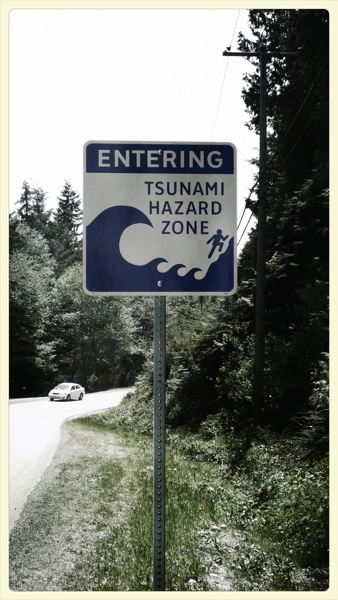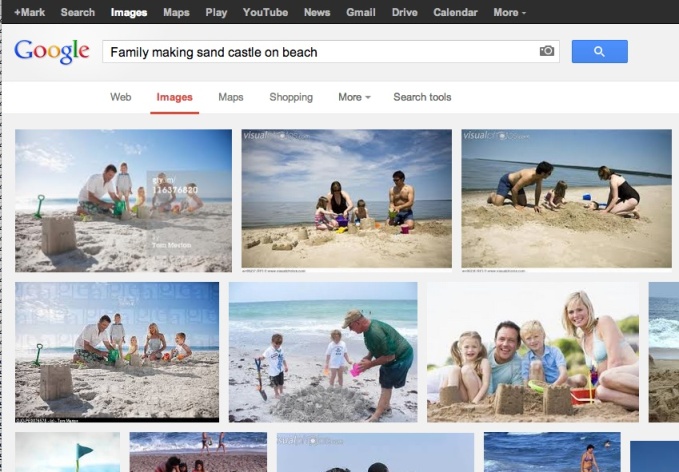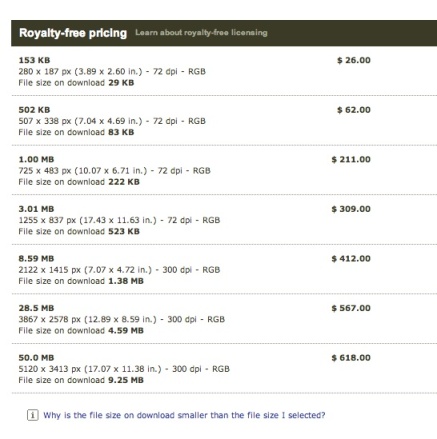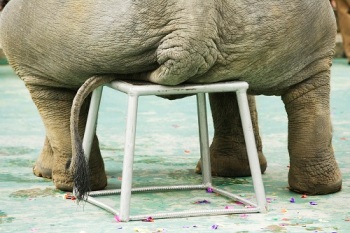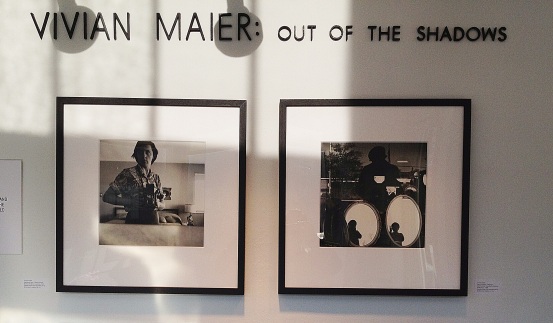New Dylan Video Celebrates FSA Color Photography
To celebrate the re-issue of Bob Dylan’s “Another Self Portrait“, Columbia Records released a video to help promote the previously un-released song “Pretty Saro.” The video, directed by Jennifer Lebeau features color photography from the famous Farm Security Administration archive. While many of us are familiar with the iconic images from FSA, we applaud Lebeau for focusing her curation efforts on the color stills and motion images from this remarkable archive. The video features portraiture, industrial, agricultural, and ephemera from photographers Alfred T. Palmer, Jack Delano, Russell Lee, Marion Post Wolcott among others.
If you like what you see here, you can browse all of the color images from FSA on Flickr or search for specific images on the Library of Congress website.
What’s not to like?
We Are Lost For Words
Here’s an opinion. Something to throw into any discussion that seems in need of a little livening up.
We need some new words to describe photography. In particular, we need a heap of new words to describe that thing we tend to call a photo (formerly photograph).
If we don’t, the corporate thought-police are going to take over photography.
Those files we have lurking in the phones in our pockets right now…we call them photos, but it’s akin to describing everything we wear simply as ‘clothes’. Yes, they are clothes. A useful catch-all word. But if that was the only word we had to describe a shirt, jacket, socks, etc., then making ourselves understood at times would get a whole lot harder.
Same with photos. All those different image files sit under the photo apps but they’re not photography as we once knew it.
Most of my photos are notes, not carefully constructed images but reference shots. Quite a few of the images are shared from others and they are communications of a different kind often – poised as some kind of illustrative element that is entirely connected with a related short text. In the same way that the words will no longer come as a grammatical sentence of old, so too has the image not come as a finely formed photo.
Various social media, of course, have taken possession of relabeling the image in their own brand form. Instagram, Twitpic, Snapchat… they frame and shape and deliver something that is a particular kind of image, a sub-set of photography.
The problem with that is that large corporations are taking over defining photography – and soon we will be speaking with their brands as the only tools we have for actually describing what we are doing.
It’s time to resist. I’d like to think we can do so. Here at Evolve we enjoy all those social media, we love the technologies, and we love the way they’ve helped create a culture that might see a trillion images being taken around the world next year. Yes, one trillion! But one trillion what?
We think it is time the photographer, the members of the thinking image-making community, started finding a way of talking about this incredible cultural explosion. It should be a language that comes from the heart rather than the corporate brand guidelines.
Any words you’d suggest to help curate the trillion?
Blog post by Lewis Blackwell, Chief Creative Officer, Evolve Images
Made In America
As a long time fan of B/W photography, I was delighted to discover in our local post office this weekend a set of postage stamps from two early masters of the medium. Unbeknownst to me, the US Postal Service recently issued a limited edition set of stamps designed to celebrate the American worker as captured through the lens of Lewis Hine and Margaret Bourke- White.
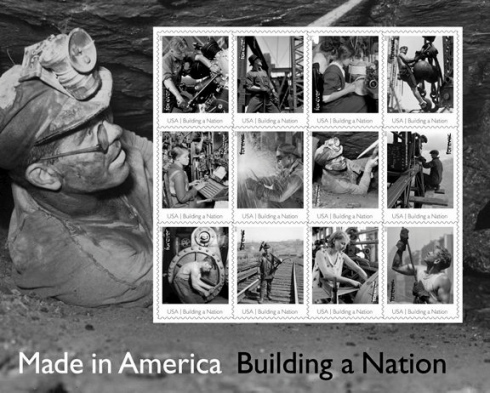
The “Made in America: Building a Nation” U.S. Postal Service stamp issuance, launched Aug. 8, honors the workers. (Courtesy US Postal Service)

Photo Credit: Lewis Hine, Courtesy of George Eastman House, International Museum of Photography and Film. (Courtesy US Postal Service)
Whenever I consider images from this period, I immediately reflect not only on the power of the work itself, but the conditions and risks Hines and others took to create them. Whether Hine’s image at right of a worker dangling from a crane or Bourke White’s female welder, these were dangerous places for photographers to practice their craft and as such elevate them from mere portraits to participants in the industry being depicted.
If you are a fan of classic white black and white photography make sure you get a set (or four) of these classic images to adorn you next letter, package or postcard. Your fellow photo loving friends and family will thank you.
To celebrate contemporary images of manufacturing and industry, see our gallery featuring work from Brownie Harris, Shannon Faulk, John Henley and many others.
The instanding image
Every now and then, being on both sides of the picture business (as a partner in Evolve, and sometimes as a client), I try and note what photography I personally find useful in a given hour or two. It’s a visual audit, a reality check of sorts on what seems to be working for me.
The results of this can give insight on what we are doing right here or what we might develop.
Today, for example, it included: a classic archival shot of a building I was reading up about on wikipedia; a well-taken product shot of a jacket in the newspaper; and a misty view across a rainforest. Yes, random. There’s a lot more of that. The trick is to look for the patterns.
These images tend to be anything but outstanding. But they really function – they are embedded in the content they deliver in a way that is as important as any verb, noun or comma in the associated text. They absolutely work and do so as part of a structure of communication elements.
This is, for me, an important part of understanding how imagery is developing in our world. It’s becoming an ever richer and more complex language, one that we increasingly read and use better than aspects of our spoken or written language.
When we send or share pictures via social media we often do it with images that are closer to this vernacular than to being an icon image. The images are visual notes, elements in a communication, and with no aspirations to be a framed print or a full-page ad.
We’re all increasingly this kind of photographer. Or reader of photography. And, with the way archives are open to share (legally or not so legally) we mix up the old with the new in a rich stew of visual content.
Some of the images we add to our collections, often some of the ones shot on smartphones, are perhaps in this area. They’re images that straddle a line between the new language ‘element’ and the more iconic shot.
These images need a description – so, for me, I’ve been calling them ‘instanding’ as opposed to outstanding. They’re pictures that are really made to sit inside a message, a component. Some can also work iconically, i.e. Be outstanding. But the main need in communications is to find that great image that can be instanding, can work alongside as a natural team player.
An example, would be something as simple and yet appealing and conceptually charged as Ron Fehling’s image of a coffee cup.
It’s a note of a modern phenomenom – the culture of decorated cappuccino froth. It says care, love, taste, style and, of course, service. (Don’t tell me you do this to your own coffee at home.)
It’s instanding. Isn’t it?
blog post submitted by Lewis Blackwell, Chief Creative Officer, Evolve Images
What does the second screen really mean?
There’s often much to dislike about the terms the marketing business coins to describe a new wheeze/exciting new concept that will change civilisation as we know it. One of those terms is ‘the second screen’. Given my feelings, I’m a natural to chair a panel on the topic. At least, I have a bigoted position and enough ignorance to scrape away at the topic and see whether it is shiny or bleeding at the end.
And so chair a panel on ‘Brands and the Second Screen’ is what I did for The Drum Live. Thanks to Jon Block (ITV’s controller of commercial digital products), Miles Lewis (VP of ad sales at Shazam) and Dave Coplin from Bing/Microsoft, I was surrounded by some smart folk who knew a lot more than I when it came to answering ‘whither second screen?’. But first, let’s get that prejudicial feeling out there.
I dislike ‘second screen’ because, a) it presumes that TV might be the first screen, when this is not necessarily the case, and b) it shapes our perception of the content that can be linked between devices. At one level, clearly we need those blinkers. If like Jon Block you’re from commercial television then you may be inclined and obliged to view the potential of alternative media in terms of friend or foe for your medium. Your focus must be on devising smart opportunities to interact and extend your brands, and those of your advertisers, into the phones or tablets lurking around the viewer’s sofa and so help capture the eyeballs, fingers and finance.
If you are from the new world order of Shazam, as with Miles Lewis, where perhaps 300 million users enjoy its music recognition app (many being led to buy music through it), you are more sanguine about TV. But you still have a great interest in taking a share of more traditional advertising and are interested in a linked service that can extend the on-TV content to revenue generation through your interactive service. This may inadvertently help defend the TV medium and its sense of being the first screen, so still somewhat ‘second screen’ in its logic.
It fell to my panelist from Microsoft, a visionary from Banbury who would have much to discuss with the oracle of Delphi, to get away from the immediate business potential of second screen and instead muse more ecstatically on the potential connectedness of all things. Or at least all things media. As Microsoft UK’s chief envisioning officer, Dave Coplin has an enviable and challenging job. Enviable because he can think very big thoughts, while also challenging because that kind of thinking can fly off into the blue sky and never come back down. And if it does come back down it is sometimes like a deflated balloon, a shrivelled spent husk of its original promise.
But Coplin’s vision flies confidently. He draws us away from being overly ‘second’ about our screen-thinking. The opportunity, as he puts it, is to link the interactive experience through any appropriate media. That could be books, or other print, with digital. That could, and should, be sound and image. Indeed, anything sensory can link. The potential for that in retail becomes rather wonderful in time as touch and scent are engaged more fully in our interactions. In a recent article Coplin wrote: “For brands, the challenge will be ensuring that the consumer journey is stitched together in a relevant, contextual way.” He didn’t push that point home, but left its implications tantalisingly in the air.
But as a second screen skeptic I will make a more pointed remark. It strikes me – in a week when I am again impressed and learning from the continued growth of ASOS – that there is a very clear first-screen that all brands must situate themselves around sooner or later, and that is the hand-held personal screen. That might be as a phone, or tablet, or some in-betweeny thing. It seems to be stating the obvious, but apparently not.
The simple logic is that if you are customer-centric, then the screen that is the extension of the customer is the starting point for the connection and the content. A personal screen-enabled customer is increasingly the building block of customer knowledge, of data, of marketing. That doesn’t necessarily mean you spend much or most of your budgets there today, or even tomorrow, but you do devise your thinking around this emerging definition of most customers in the world. For certain, it means we stop saying ‘second screen’ when we mean ‘first-screen’.
Posted by Lewis Blackwell, Chief Creative Officer, Evolve Images. Read more at The Drum.
View From The Top
If you want to find out how to take pictures at 8km per second, or how to really be an ‘out of this world’ photographer, then check out this recently posted video from Chris Hadfield.
It’s a quick primer from a Canadian with a neat ‘stache hanging out in the space station and taking some darn good pictures that, I am willing to bet, you can’t match. But do prove us wrong!
Chris takes us through his kit and his technique. He tells us about his three-point process and what time of day he really likes to look down on the Sahara. He tells us a few other things that makes it seem like a jolly photo expedition hanging around in a glorified tin can in space, prey to a whole universe of equipment malfunction.
The overall effect is to make you feel like a big kid and just fall in love again with the romance of being an astronaut.
And if you want to know how this celeb photographer keeps his facial hair quite so neat, or brushes his teeth, cooks his dinner, etc. you can go to one of the other videos also uploaded by Chris and the Canadian Space Agency and view-able at youtube.
Image Buyer’s Guide Tip # 1: Never Pay Too Much For An Image
Editor’s Note: This post is the first in a series we plan ultimately to publish as a standalone guide that can be shared widely to help educate photo buyers on the best practices when licensing images from photographers, stock agencies, archives, libraries, or other sources. If you are a photo buyer and would like to share a tip, technique or best practice that you’ve used to help you license great images for your projects, please email, Tweet or post your ideas and we’ll contact you to have you featured in a future post.
Ever fall in love with a great image only to find out the fee published on the the website is more than your budget can handle? What to do? While it’s always good practice to have a 2nd or 3rd choice as a back-up in case you really can’t get your first choice at the price that will meet your budget, here are some tips to make sure you are getting the best price you can:
1) Comparison shop: Unless the image you’ve identified is only available exclusively from a single agency or photographer, try Google Image Search to see if your image is perhaps available from more than one source. Here is an example of a search we did for images of “Family making sand castle on beach.” At the top right of the results we found the identical image available from AGE FotoStock and Getty Images:
Clicking on each image takes us to the pricing page for each photo. The result? AGE FotoStock’s prices for this image range from $49 USD to $489USD. The same image priced at gettyimages.com starts at $26 USD to a high end of $618 USD. Both agency’s prices are determined by the file size you choose to purchase.
2) Call or email the photographer or agency: Even if the website has a published price (as per the examples above) often times a simple email or phone call can yield you a lower price. Whether you are a first time client or a repeat buyer, agents and photographers know they have to compete for your business and more often than not are willing to “reward” your purchase with a lower price.
3) Buy more than one image: Whenever you purchase more than one image from a single agency or photographer it is customary for the buyer to expect a discount. If the agency or photographer does not advertise this, again, call or email and ask for the “multi-image rate discount.”
4) Invest in a subscription: If you find an image sourced from one of the many subscription image services that are available, often the price of a single image can offset a significant percentage of the total fee of a subscription. Shutterstock offers this image as a single image download for $19 however they also offer a one-month subscription where you can download as many as 25 images per day every day for a month (a potential value of $9500) for just $249.
5) Extra Credit: License Your Images at the End of the Month or Quarter: While it may not always make difference, stock agencies often set aggressive revenue goals for their sales teams and sometimes the pressure on reps to meet these goals can work to a buyer’s advantage. Agency reps, especially those who are commission based, are driven to close as many sales before the end of a month or quarter. Timing your call to ask for a lower price at the end of a month, when a rep is trying to achieve his or her sales target, can yield a larger discount than a call placed to the same rep at the beginning of a month or fiscal period.
How do you get your best prices for images? Please post a comment below.
Editor’s Note: If you have a question about how to license images, let us know and we’ll post a response and ask our readers to chime in as well. Disagree or have an alternative point of view? We invite your comments and feedback. Thanks!
The Internet Of Things: The Elephant In The Room That Threatens to Squash Us
This article by Evolve Images Chief Creative Officer Lewis Blackwell was recently published in The Drum.
I’ve had coffee with an ambassador who represents the elephant in the corner of the room.
It is a virtual elephant in a virtual room. But it is a room we’re all in and the elephant threatens to squash some of us. Even in virtual rooms there’s only so much space.
The ambassador’s name is Andy Hobsbawm. We’ll get to the elephant’s name in a moment. Andy’s something of a digital guru (in the Digital Hall of Fame, no less ) and one of the founders of the business EVRYTHNG.
He and his colleagues are concerned with developing ‘the internet of things’. That’s the elephant. They point out that we are at a point where everything significant that we buy could carry a digital signature to be uniquely identifiable and connected so as to create a web of things. The life of that bottle of water on your desk, or the shoe on your foot, can be trace-able, link-able, and thereby carry intelligence. About you as well as it.
It sounds a little far-fetched and yet it is already here. Andy’s company is doing projects with the likes of Diageo, while the link between Apple and Nike+ is well established, enabling our running shoes to chat to our iPhones and computers and entertain the web with our efforts to get fit.
Anyway, Andy’s business gives me a headache quite quickly as I struggle to imagine the implications of the humungous data generated by everything we touch. And then there’s the data generated by mixing up the data with other data in order to create more data that predicts the future and reshapes our existence. Got that? Just a little scary, yes?
I don’t mind my bike or my fridge talking about my habits but the implications of underwear or individual deodorants having their own Facebook page, or the web-of-things equivalent, is mind-boggling. What if – oh dear, how embarrassing – you don’t appear to have a deodorant life? Too much information or not enough, either way as we become even more defined by our consumption this could get vicious. I can sense a lobby forming to say our rights are being eroded in ways that go way beyond what Google’s done to us so far.
But never mind the encroachment, there seems an inevitability about the internet-of-things. It’s going to creep up on us rather fast – elephants do move amazingly quickly – and then sit right on us. It could crush several aspects of the media and marketing landscape we know and love and earn our livings from.
The internet-of-things will change how we define and spend across media, what we think of as marketing, and how we conceive and design products. Just a few alterations to consider then.
Everything becomes media (once again, Marshall McLuhan’s crazier statements become true). Everything will be developed and designed with a view to how it is no longer a dumb product but one that communicates. Endlessly. We will need to plan and control the interaction with a stream of information from the birth of the product through all its mediations unto its death. Us do part. Of course, in some cases, our death may come the sooner and that will be a little blip of data in the life of the product.
I’ll finish by mashing this thought with something shared by Sir Martin Sorrell recently. He wrote that American consumers spend less than 10 per cent of their time on newspapers and magazines, but more than 20 per cent of marketing budgets are spent on these traditional media.
And these consumers apparently spend a third of their time on the internet and mobile while only 20 per cent of budgets are spent on those media.
Sir Martin concluded that things must change. His clarity with stats, and his position at the head of the mighty WPP, makes it seem inevitable. The pressure is mounting and at some point the spending – and thinking – will slide more rapidly from traditional to digital. But some of that digital media is already looking old. What the internet-of-things proposes to do is reshape aspects of the digital offer, adding a higher level of measurement, accountability and control that makes the case even more compelling to spend there. The future of media and marketing will look very different again.
Now I’ve forgotten to tell you the elephant’s name. Feel free to propose one below. A delightful old media souvenir to the best suggestion.
Out Of The Shadows and Into The Light
To share or not to share? Remain in the dark or step into the light? In the over-sharing reality-tv-mobile-social-insta-googling world in which we live, it’s hard to remember a time when photographers made the conscious decision to rarely, if ever, share their work. Yet, in spite of the ease with which photographers can share their work today, even among professionals, there is often a reluctance to share work with peers, potential clients and other artists. So the question should be asked: can you afford not to share your work?
On one end of the extreme, I offer the case of Vivian Maier. Maier’s work came to light in the last few years when a cache of her unpublished, unseen images were discovered by a realtor, who sight unseen, bid on Maier’s remaning life possessions contained in an abandoned storage locker. The realtor got more than he bargained for unearthing more than 100,000 photographs Maier captured during a more than four-decade period of daily shooting. It was also learned that during her lifetime, Maier never shared any of the photography which she produced at a prodigious rate.
While Maier’s talent and tenacity as a photographer is undeniable, I can not help but wonder: How much further would Maier have been able to push her craft, range and talent had she only taken the simple step (but obviously difficult for her) of sharing her work and getting valuable feedback from editors, photographers or other image professionals?
In contrast, flash forward to an event I participated in last week: “Portfolio Perfect” co-hosted by ASMP and ASPP where the spirit and intent of the evening was expressly designed for photographers to improve their craft by listening to and integrating feedback from peers and respected industry professionals. Dozens of photographers from the greater Portland-area turned out for one-on-one portfolio reviews conducted throughout the evening. I especially applaud the 37 photographers who submitted images for the “live audience review” as they offered themselves up to be particularly vulnerable, but in fact, extracted probably the greatest value from the event by getting unedited, unfiltered yet constructive feedback about their work.
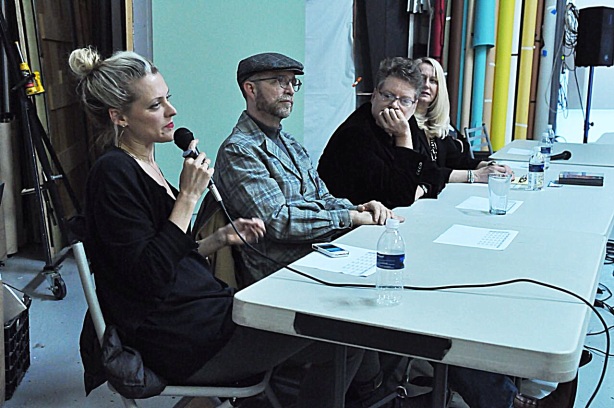
Portfolio reviewers (l-r) Marni Beardsley, Jerry Ketel, Steve Sandstrom and Danita Delimont critique photographer portfolios during “live review” © evolveimages.com
As one of the reviewers, I was struck, that even among this group of professional photographers, whose very livelihood are dependent on sharing their work with others, how many photographers were either reluctant to share their work or openly admitted that they did not regularly seek feedback about their work. Whether drawn by the mystique of executing a singular, artistic vision or the pursuit of creating self-inspired work, withholding your work from critique is a flawed approach– especially for photographers yet to establish a reputation or distinctive style that they can truly call their own.
It can be argued that all creative pursuits— writing, music, dance, design, painting, photography– benefit from considered critique, editing and feedback. In fact, it is all too easy to spot work that is highly self-indulgent where the only audience being satisfied is the ego of the creator.
So if you’ve been hiding your work from others, yes, you can take your chances that one day you too could be immortalized after you’ve left this life as another great talent “undiscovered” during their lifetime. A more pragmatic approach, one which yields more predictable and realistic results, would be to start sharing your work with others today. Integrating constructive feedback will more likely lead to your producing consistently improved, memorable and satisfying work.
Get out of the shadows and into the light.





